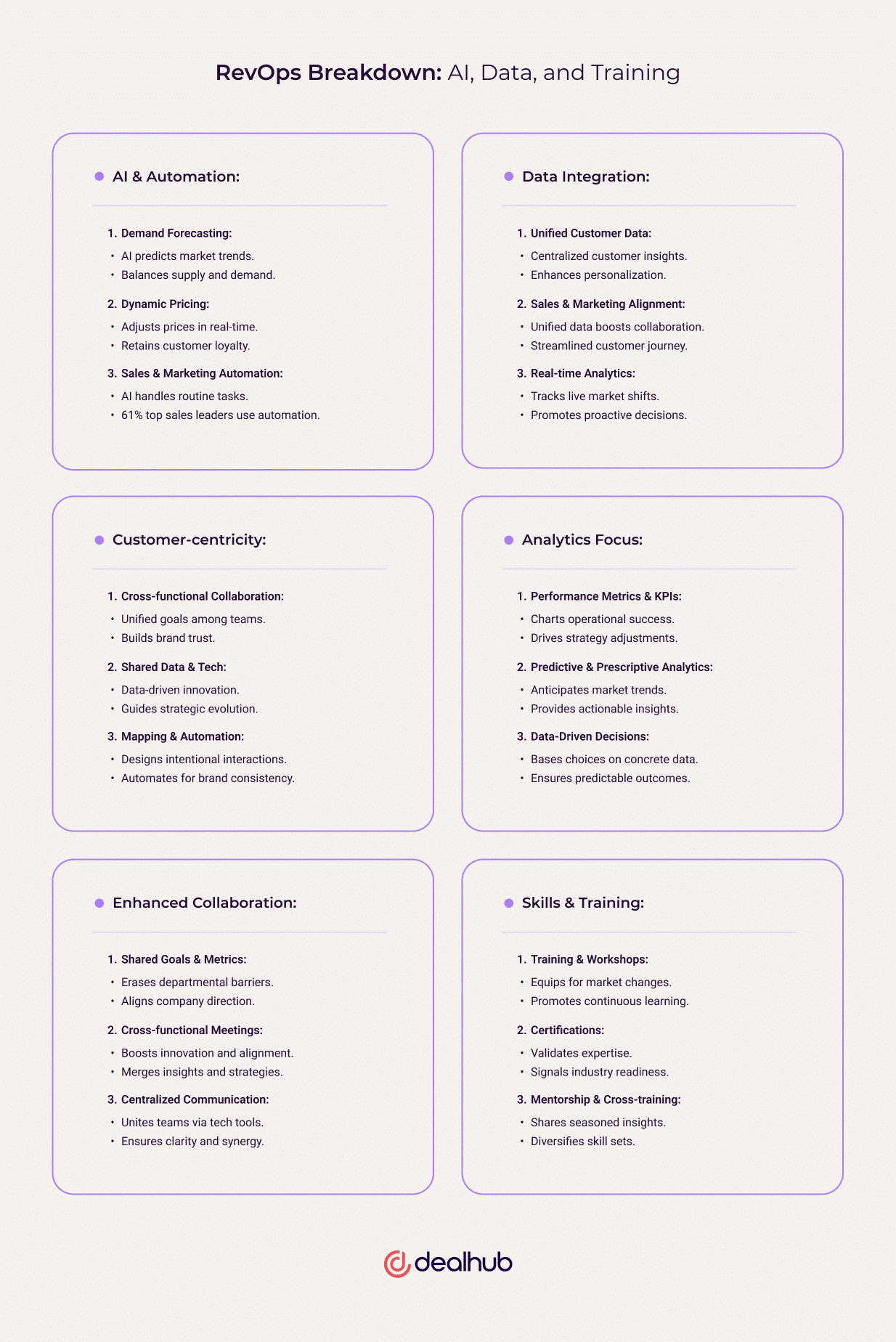AI and automation
AI’s increasing role in RevOps cannot be overstated. From predictive analytics that improve forecasting accuracy to automation of repetitive tasks, AI is primed to make RevOps more efficient and effective.
Three ways companies are leveraging AI in RevOps include:
Demand forecasting
With the mainstreaming of AI, RevOps can see the future like never before. AI’s predictive prowess reveals hidden market trends, unveiling once elusive demand patterns.
The trend toward AI-powered demand forecasting will become the cornerstone of operational excellence. With AI-driven demand insights, RevOps can orchestrate strategies that resonate with customers, creating experiences that are attuned to their needs. Past dilemmas, like overstocking or understocking become a thing of the past, replaced by supply that meets demand with precision.
Dynamic pricing and revenue management
With AI enabling dynamic pricing, companies can react to market fluctuations to optimize revenue streams while maintaining customer satisfaction.
AI can analyze market dynamics, competitor moves, and customer behaviors with a precision that human analysis can’t match. It suggests pricing adjustments that respond in real-time to market shifts, striking a balance between profitability and affordability. AI-driven dynamic pricing also ensures that customers perceive the value of what they pay for, keeping them engaged and loyal.
Sales and marketing automation
AI has the power to take over repetitive tasks, from data entry to email campaigns, allowing human talent to focus on strategy.
61% of overperforming sales leaders are already using automation in parts of their sales process. And, to maintain a competitive edge, the most effective sales and marketing teams must be liberated from monotonous tasks.
When sales and marketing teams can avoid tedious admin, they can focus on understanding markets, analyzing customer behaviors, crafting strategies, and nurturing client relationships. With AI-powered automation, RevOps professionals become the architects of experiences that drive revenue growth.
Data integration
As companies accumulate more data from different sources, the importance of data integration increases. After all, in 2022, 45% of sellers still said their biggest challenge was incomplete data. The coming years will see more companies breaking down data silos and creating a single, unified view of customer data to drive revenue decisions.
Three ways companies are leveraging data integration in RevOps include:
Unified customer data
In the past, customer data was scattered across departments, databases, and systems. In modern RevOps, unlocking customer insights begins with data integration.
With a comprehensive view of customer data, RevOps teams can track the buyer enablement from the first touchpoint to brand advocate. This knowledge fuels strategies that resonate on a personal level. With unified customer data, ReOps can craft tailor-made experiences, recommendations, and offerings based on each individual’s preferences and needs.
Sales and marketing alignment
RevOps continues to centralize insights by enabling sales and marketing to join forces. Unified data invites seamless collaboration. Marketing/sales synergy, powered by data integration, improves efficiency and amplifies revenue generation through strategies that align across the customer journey.
United by shared data, sales and marketing can find common ground. Imagine the revenue potential when sales knows precisely which marketing efforts led a customer to their doorstep and marketing understands the nuances that convert leads into loyal patrons!
Real-time analytics for decision-making
Integrated data allows the tracking and analysis of customer interactions and market movements in real-time. It’s not just about understanding what happened; it’s about sensing what’s happening and seizing opportunities as they unfold. Consider a scenario where a sudden surge in demand is detected. With real-time data, companies can swiftly adjust production, fine-tune pricing, and deploy targeted marketing campaigns to capitalize on the trend.
The ability to make informed decisions amid uncertainty is a substantial competitive advantage. This real-time analytical prowess elevates RevOps from a reactive entity to a proactive powerhouse.
Customer-centricity
As businesses increasingly recognize the importance of customer experience in driving revenue, RevOps will be more centered around the customer journey. This means aligning all revenue-related functions (sales, marketing, customer success) around common customer-centric goals.
Three ways companies are unifying their RevOps around the customer journey include:
Cross-functional collaboration
With collaboration between sales, marketing, and customer success synchronize their efforts to create holistic customer experiences. Armed with marketing insights, sales teams craft pitches that reflect the essence of customer preferences. Meanwhile, customer success steps in with personalized support that ensures customer satisfaction from onboarding to long-term engagement.
This focus on brand consistency translates to trust – and brand trust builds revenue. In fact, 46% of US consumers were willing to pay a higher price for a trusted brand. Cross-functional collaboration that makes delightful customer experiences results in long-term relationships that translate to bottom-line growth.
Shared data and technology
Customer-centric RevOps is a space where shared data acts as the catalyst for innovation and strategic refinement. With integrated data and shared technology, teams gain insights that spark innovation. Marketing understands which campaigns resonate most, while sales learns which pitches strike the right chords. As customer behavior evolves, these insights become the compass guiding strategy evolution.
Companies that align people, processes, and technology across their sales and marketing have 36% more revenue growth and as much as 28% more profitability. Collaboration-driven innovation is the essence of customer-centric RevOps, where data isn’t confined to a department but flows freely to empower the entire company and directly serve the client.
Mapping and automation of touchpoints
A successful customer journey must be well-defined. In modern customer-centric RevOps, touchpoints are mapped and automation creates a seamless experience that encourages loyalty.
With meticulous mapping, every interaction becomes intentional. Marketing, sales, and customer success align touchpoints, ensuring a consistent brand experience. Automation steps in to prompt interactions that respond to customer behaviors in real-time. This balance of mapping and automation encourages a journey where customers are led through an experience carefully designed to transform them into brand advocates.

Greater emphasis on analytics
The ability to capture and analyze data for decision-making is becoming more essential in making data-driven decisions, optimizing processes, and enhancing revenue growth. This includes tracking key performance indicators (KPIs) across the entire customer lifecycle to measure the effectiveness of RevOps strategies.
Three ways companies are emphasizing analytics in RevOps include:
Tracking performance metrics and KPIs
For RevOps, performance metrics and KPIs can chart success. The most helpful metrics RevOps can leverage include:
- Conversion rates to reveal the effectiveness of customer journey approaches.
- Customer acquisition cost (CAC) to shed light on the efficiency of our customer acquisition strategies).
- Customer lifetime value (CLV) to showcase the effectiveness of interactions with customers.
- Pipeline velocity to reveal how quickly leads move through the sales pipeline from the initial contact to closing the deal.
These insights shape strategies, fine-tune operations and fuel the relentless pursuit of excellence.
Predictive and prescriptive analytics
Imagine the power of being able to react proactively instead of reactively to data! In this brave new world of RevOps, leaders are fueled by predictive insights to anticipate trends, spot opportunities, and adjust as events unfold.
There’s peering into the future, and then there’s having a step-by-step guide to success. Enter prescriptive analytics. It’s not content with telling us what might happen; it offers a roadmap to what should happen. That way, RevOps doesn’t just adapt; it games out strategies with precision to transform possibility into reality.
Data-driven decision-making
With a solid layer of data in front of RevOps teams, decisions no longer need to be guided by intuition. Every decision is rooted in data that’s been collected, analyzed, and understood.
From resource allocation to strategy refinement, RevOps doesn’t gamble on success. It crafts its journey with the certainty that comes from data-driven decision-making. The result? Strategies that are backed by evidence for more predictable outcomes.
Enhanced collaboration
As RevOps encompasses multiple departments, practical collaboration tools and strategies are paramount. This could include the adoption of digital workspaces or collaborative software to improve communication and coordination among teams.
Three ways RevOps leaders are focusing on collaboration include:
Shared goals and metrics
The essence of advanced collaboration in RevOps is sharing goals. Shared goals and metrics act as threads that unite teams in a unified purpose, erasing the boundaries that once hindered growth.
Marketing and sales are intertwined in this collaborative realm when goals transcend departments. Metrics are no longer confined to isolated spreadsheets; modern RevOps approaches make them transparent to guide every team’s journey.
Cross-functional meetings and workshops
The magic of cross-functional meetings and workshops are integral in advanced RevOps collaboration. These interactions are more than mere discussions; they’re a place for conversation and innovation.
With closer collaboration, marketing insights inspire product improvements, and customer success stories spark ideas for marketing campaigns.
Centralized communication and data sharing
RevOps enables centralized communication and data sharing. Implementing collaboration tools like CRMs, project management software, and collaboration software replace fragmented communication with a seamless flow of information.
In this connected landscape, miscommunication is replaced by clarity. Sales knows what marketing is planning, marketing understands customer success insights, and customer success aligns with product developments. The result? Teams that function not as separate units, but as interconnected gears in a well-oiled machine.
Focus on skills and training
As RevOps continues to evolve, there will be an increased need for upskilling and continuous learning. This might involve training for new technologies or developing soft skills like collaboration and strategic thinking.
Three ways RevOps departments are focusing on skills development include:
Training programs and workshops
RevOps, in an ever-changing business environment, can’t settle for the status quo; it thrives on evolution. Training experiences sculpt professionals who can wield technology and craft strategies with finesse.
Training programs and workshops turn RevOps teams into agile machines capable of adapting to market shifts and operational changes. The future of RevOps is not just about acquiring skills; it’s about embracing the journey of continuous improvement in a field where evolution is the only constant.
Certifications
Think of certifications as merit badges of expertise. RevOps certifications tell a story of dedication, of hours spent mastering the intricacies of revenue optimization. In a constantly changing landscape, certifications can reflect leadership and agility, showcasing professionals who stand at the forefront of innovation.
Mentorship and cross-training
As the field continues to evolve, the wisdom of experience that can be passed down to those just beginning their journey will help strengthen the entire industry.
Mentorship nurtures growth and understanding. Seasoned RevOps leaders guide newcomers through the nuances of the field, offering insights that textbooks can’t provide. This exchange of wisdom isn’t just one way; cross-training empowers professionals to see beyond their niches.
A promising future
In conclusion, the future of RevOps promises greater integration, customer focus, and reliance on technology. By keeping an eye on these trends, organizations can stay ahead of the curve and optimize their revenue operations for success.




